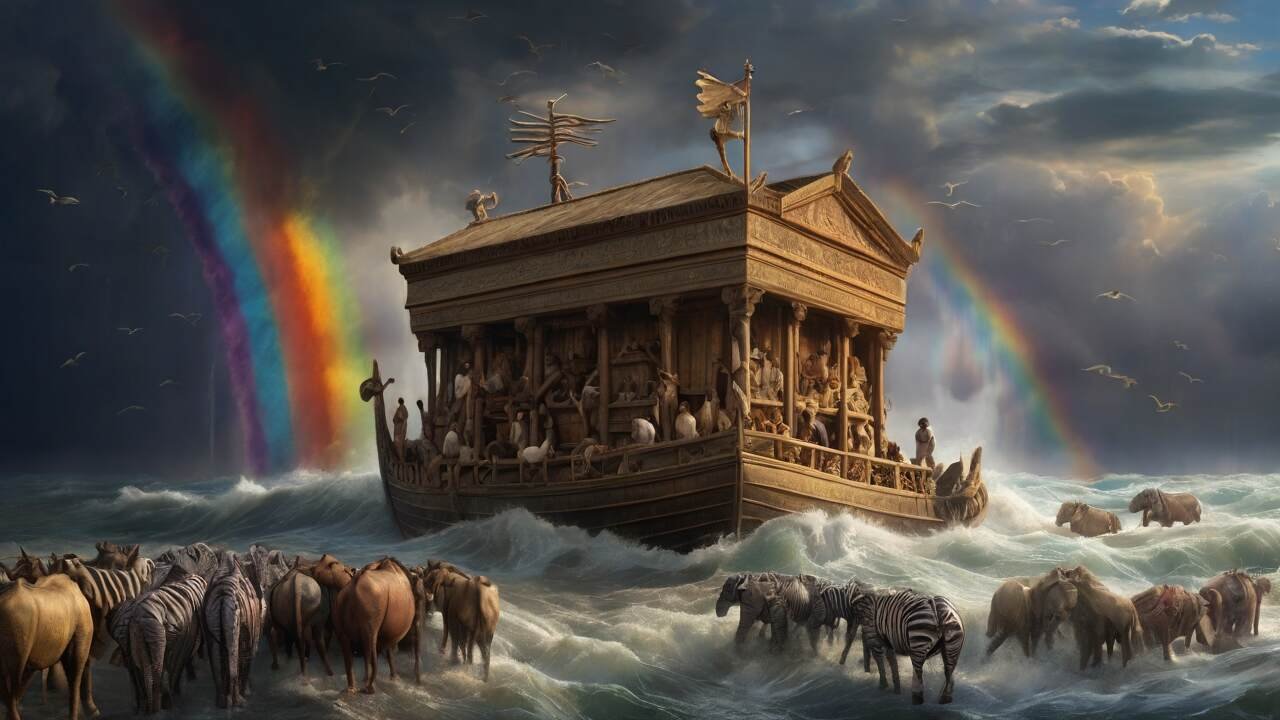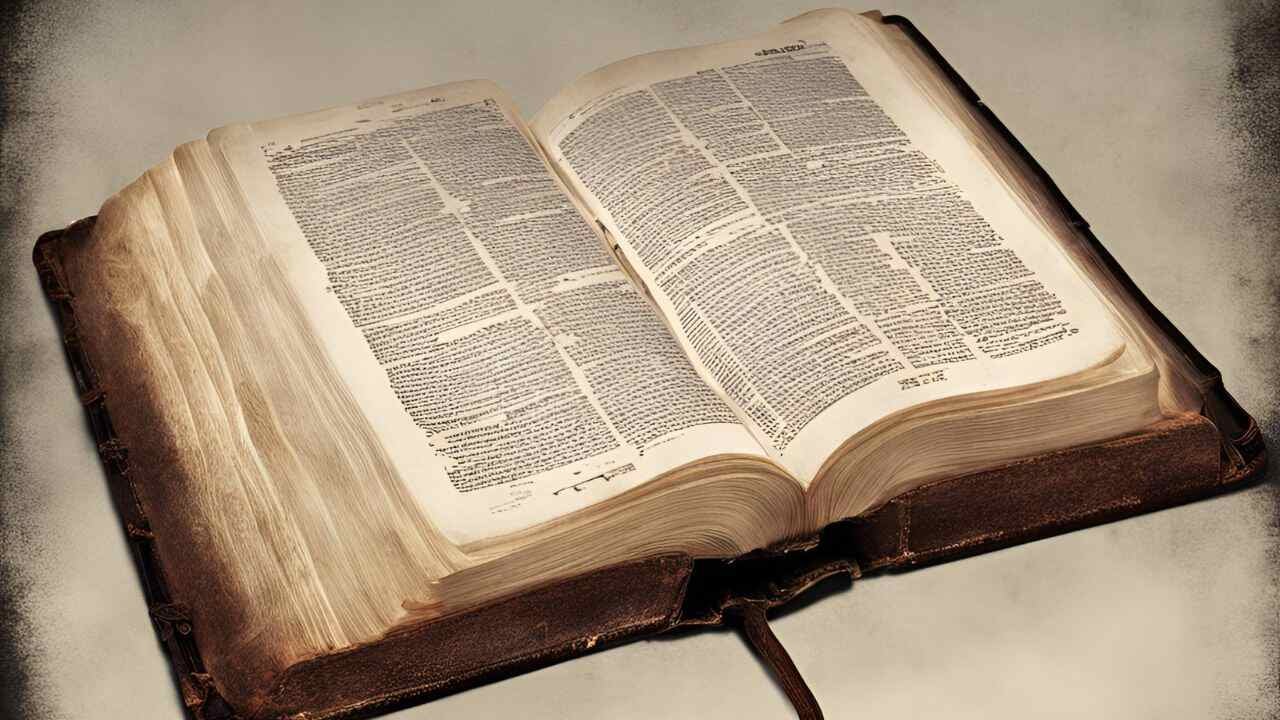The story of Naomi, Ruth, and Boaz (Ruth 1–4) is one of the most moving accounts in the Bible, set during the period of the judges, about a century before David became king of Israel. The events focus on loyalty and faithfulness that contrast the pagan Moabite culture from which the Moabite woman Ruth originated, and they are a clear example of God’s faithfulness in bringing about His plan of biblical redemption using unexpected partners.
The book of Ruth begins with an Israelite family facing tragedy, but Ruth leaves the gods of Moab behind and chooses to put her fate in the hands of Naomi’s God and His people. This story ultimately portrays God’s amazing love for all humankind and His plan of redemption.
The narrative of Ruth and Boaz, the kinsman-redeemer, is an Old Testament narrative that foreshadows the redeeming work of Christ. It is a story of God’s providence, as He orchestrates the events to bring about the restoration of Naomi’s family and the ancestral lineage of David, the future king of Israel. The concept of levirate marriage, where a kinsman redeems a deceased relative’s property and marries the widow, is central to the story and reflects God’s heart for Naomi’s family to be redeemed.
Key Takeaways
- The story of Ruth and Boaz is a powerful example of God’s redemptive plan, using unexpected people to fulfill His purposes.
- The concept of the kinsman-redeemer, as exemplified by Boaz, foreshadows the redeeming work of Christ.
- The book of Ruth highlights God’s providence and His desire to restore broken lives and families.
- The story of Ruth and Boaz demonstrates the themes of loyalty, faithfulness, and the contrast between pagan and godly cultures.
- The lineage of David, the future king of Israel, is traced back to the union of Ruth and Boaz, underscoring God’s sovereign plan.
The Story of Naomi, Ruth, and Boaz
The book of Ruth begins with an intriguing narrative that centers around the lives of Naomi, a Moabite woman named Ruth, and the kinsman-redeemer Boaz. This captivating tale unfolds against the backdrop of a time of famine in Israel, which prompts Naomi and her family to seek refuge in the land of Moab.
The Tragic Circumstances
Tragedy strikes when Naomi’s husband, Elimelech, passes away, leaving her and her two sons, Mahlon and Chilion, to fend for themselves. In a remarkable turn of events, Naomi’s sons then marry Moabite women, Ruth and Orpah. However, this happiness is short-lived, as both of Naomi’s sons also die, leaving her and her daughters-in-law in a precarious situation.
Faced with the loss of their husbands and the prospect of an uncertain future, Naomi decides to return to her homeland of Israel. Remarkably, the Moabite woman Ruth chooses to accompany Naomi, demonstrating unwavering loyalty and faith. Naomi, deeply discouraged, believes that “the hand of the Lord” has turned against her, unaware of the God’s providence that is about to unfold.
As Naomi and Ruth arrive in Bethlehem, they encounter a kinsman-redeemer named Boaz, who plays a pivotal role in the unfolding of the levirate marriage and the redemption of Naomi’s family. This remarkable story is a testament to the power of love, loyalty, and the unwavering hand of God in the midst of life’s trials.
“For your Maker is your husband, the Lord of hosts is his name; and the Holy One of Israel is your Redeemer, the God of the whole earth he is called.” (Isaiah 54:5)
Returning to Israel with Unwavering Faith
The Moabite woman Ruth made a remarkable decision that would forever impact the course of history. Despite the tragic circumstances that had befallen Naomi’s family, Ruth chose to leave the gods of Moab behind and put her faith in the God of Israel. With unwavering conviction, she pledged her loyalty to Naomi, declaring, “Your people shall be my people, and your God my God” (Ruth 1:16).
Naomi was certain that “the hand of the Lord” (Ruth 1:13) had turned against her, but little did she know that God was orchestrating an amazing plan that would eventually affect all of humanity. Through Ruth’s selfless act of devotion, Naomi’s family was redeemed, and the lineage that would lead to the coming of the Messiah, Jesus Christ, was set in motion.
Ruth’s journey from Moab to Bethlehem, guided by God’s providence, is a testament to the transformative power of faith and the remarkable ways in which the divine can work through the lives of ordinary people. Her unwavering commitment to Naomi and her willingness to embrace a new faith and culture demonstrate the incredible impact that a single individual can have on the course of history.
“But Ruth said, ‘Do not urge me to leave you or to return from following you. Where you go I will go, and where you lodge I will lodge. Your people shall be my people, and your God my God.’” (Ruth 1:16)
As the Moabite woman Ruth journeyed back to Israel with Naomi, she embarked on a path that would ultimately lead to the redemption of Naomi’s family and the fulfillment of God’s providential plan. Her story serves as a powerful reminder of the transformative power of faith and the profound impact that one person’s decision can have on the lives of many.
Through Ruth’s example, we witness the unwavering faith and loyalty that can transcend cultural and religious boundaries, ultimately bringing about a divine purpose that extends far beyond the individual. The story of Ruth and Naomi’s return to Israel is a poignant testament to the ways in which God’s providence can unfold, even in the midst of life’s most challenging circumstances.
Explore the Theme of Redemption in the Story of Ruth and Boaz
The biblical tale of Ruth and Boaz is a captivating exploration of the profound theme of redemption. At its core, this story showcases the unwavering faith and resilience of two individuals who navigate the challenging circumstances of their lives, ultimately finding restoration and purpose through the transformative power of God’s providence.
The narrative introduces us to Naomi, a woman who has endured immense personal loss, and her daughter-in-law, Ruth, a Moabite woman who chooses to accompany Naomi back to her homeland of Israel. Here, we witness the kinsman-redeemer Boaz, a righteous and faithful individual, step forward to fulfill the biblical practice of levirate marriage, redeeming Naomi’s family and restoring their connections to the community.
Through Boaz’s selfless actions, we see a reflection of God’s own heart for redemption, as He desires to restore His lost and hurting children back into right relationship with Him. The story of Ruth and Boaz serves as a powerful metaphor for the biblical redemption that God offers to all who are willing to place their trust in Him, regardless of their circumstances or background.
As we explore the redemptive themes woven throughout this captivating narrative, we are reminded of the God’s providence that guides the lives of His people, orchestrating events in ways that bring about restoration, healing, and a renewed sense of purpose. The story of Ruth and Boaz stands as a testament to the boundless love and grace of our Redeemer, who desires to see His Naomi’s family redeemed and made whole once more.
As we delve deeper into the nuances of this timeless tale, we are invited to reflect on our own stories and the ways in which the transformative power of redemption can be experienced in our lives. The story of Ruth and Boaz serves as a poignant reminder that even in the midst of life’s darkest moments, God is at work, weaving a tapestry of hope, love, and restoration that ultimately brings glory to His name.
A Love Story with Divine Purpose
The book of Ruth is often described as a love story, and indeed it does contain elements of two people, Moabite woman Ruth and her kinsman-redeemer Boaz, growing in love within the unique ways of their ancient Near Eastern culture. However, the story is ultimately about God’s amazing love for all of humanity, specifically His desire for His people to not only experience His love for themselves but to also reach out and display it in such a way that God is made known to His lost, hungry, and hurting children.
The Meaning of Ruth’s Request
Ruth’s request to “spread the corner of your garment over me” (Ruth 3:9, NIV) had several profound meanings, each of which highlighted her desire to be a faithful part of the community of God’s people, seeking Boaz’s protection and provision as her kinsman-redeemer. This request was a symbolic gesture, invoking the concept of levirate marriage, where a male relative would marry a widow to continue the family line. It was also a plea for Boaz to exercise his role as her kinsman-redeemer and take responsibility for her wellbeing.
Moreover, Ruth’s request demonstrated her trust in God’s providence and her willingness to submit to His plan for her life. By seeking shelter under Boaz’s “wing,” she was acknowledging her dependence on the God of Israel and her desire to become part of His chosen people.

“Ruth’s request to ‘spread the corner of your garment over me’ (Ruth 3:9, NIV) had several profound meanings, each of which highlighted her desire to be a faithful part of the community of God’s people.”
The significance of Ruth’s request goes far beyond a simple marriage proposal. It is a testament to her faith, her loyalty, and her willingness to embrace the God of Israel as her own. Through this act, the story of Ruth and Boaz becomes a powerful illustration of God’s redemptive plan unfolding in the lives of those who trust in Him.
God’s Redemptive Plan Unfolding
The story of biblical redemption woven through the lives of Ruth, Boaz, and Naomi unveils God’s divine providence in a profound way. As Ruth, a kinsman-redeemer Boaz eventually marries, the concept of levirate marriage is beautifully displayed, ultimately redeeming Naomi’s family from the tragedies they had endured.
Ruth’s unwavering faith and commitment to Naomi paved the way for her to become part of God’s chosen people, demonstrating that God’s providence extends beyond ethnic or cultural boundaries. Her integration into the community of Israel, culminating in her marriage to Boaz, foreshadows the inclusion of all humanity in God’s redemptive plan through the Messiah.
The fact that Ruth became the great-grandmother of King David is a powerful testament to God’s ability to use anyone, regardless of their background, to fulfill His ancestral lineage of David. This lineage would ultimately lead to the birth of the Messiah, Jesus Christ, who would redeem all of humanity.
“For I know the plans I have for you,” declares the Lord, “plans to prosper you and not to harm you, plans to give you hope and a future.”
The story of Ruth and Boaz, with its themes of biblical redemption, kinsman-redeemer, levirate marriage, and God’s providence, not only showcases the foreshadowing of Christ but also demonstrates that our Heavenly Father has a divine purpose for each of our lives, regardless of our circumstances.
Lessons of Love, Loyalty, and Providence
The story of Ruth and Boaz in the Book of Ruth is a captivating tale that offers profound lessons about love, loyalty, and God’s providence. These themes resonate deeply, providing inspiration and guidance for readers seeking to live lives of purpose and faith.
Ruth’s unwavering loyalty to her mother-in-law Naomi, even in the face of personal hardship, sets a powerful example of selfless devotion. Her decision to accompany Naomi back to Bethlehem and care for her demonstrates that true love transcends cultural and familial boundaries.
Through the story, we witness God’s providential care for the vulnerable and downtrodden. Naomi’s loss of her husband and sons could have left her destitute, but God orchestrated events that led Ruth to the field of Boaz, a kinsman-redeemer who would restore their family. This remarkable display of divine intervention reminds us that God is actively involved in the lives of His people, even when the path ahead seems uncertain.
- The Book of Ruth teaches us that love can conquer all barriers and that true loyalty is a rare and precious virtue.
- We learn that God’s providence is at work in our lives, even when we can’t see it, and that He is concerned for the weak and the marginalized.
- The story of Ruth and Boaz is a powerful reminder that God’s redemptive plan is unfolding, and that He orchestrates events for the benefit of His people.
“Ruth replied, ‘Don’t urge me to leave you or to turn back from you. Where you go I will go, and where you stay I will stay. Your people will be my people and your God my God.’” (Ruth 1:16)
This iconic passage encapsulates the depth of Ruth’s love and loyalty, serving as a testament to the enduring power of commitment and the transformative nature of faith.
The story of Ruth and Boaz is a timeless treasure, reminding us that even in the midst of life’s trials and tribulations, God’s providence is at work, guiding us towards redemption and restoration. By studying this captivating narrative, we can glean invaluable lessons about the transformative power of love, the importance of loyalty, and the unwavering faithfulness of our Heavenly Father.
Timeless Truths for Today
The timeless tale of Ruth and Boaz offers a treasure trove of applicable lessons for Christians today. Through this story, we can learn invaluable principles that continue to resonate and guide us in our own lives.
Compassion for the Marginalized
The Book of Ruth reminds us that God is deeply concerned for the vulnerable, including the poor, widows, and foreigners. As members of God’s family, we are called to extend love and generosity to those in need, just as Boaz did when he welcomed Ruth and provided for her.
Conquering Barriers through Love
The story of Ruth and Boaz teaches us that love can transcend even the most daunting social and cultural barriers. Their union, despite their different backgrounds, illustrates the power of love to unite and overcome divisions. As Christians, we are to love everyone, regardless of their circumstances or past.
Trusting in God’s Providence
The Book of Ruth is a testament to God’s redemptive work in the lives of His people. Even when circumstances appear bleak, as they did for Naomi and Ruth, we can have faith that God is at work, weaving a tapestry of love, loyalty, and God’s providence for our ultimate good.
These timeless truths found in the story of Ruth and Boaz continue to inspire and guide us in our own journeys of love, loyalty, and God’s providence. As we reflect on the applicable lessons within this cherished biblical narrative, we are reminded of the transformative power of faith, compassion, and trust in the sovereign plan of our loving God.
Conclusion
The captivating story of Ruth and Boaz stands as a testament to the power of biblical redemption. This Old Testament narrative masterfully weaves the tale of a Moabite woman Ruth and her kinsman-redeemer Boaz, revealing God’s unwavering providence and His plan for the ancestral lineage of David, foreshadowing the coming of the Messiah, Jesus Christ.
Through the intricate tapestry of levirate marriage and Naomi’s family redeemed, we witness the transformative power of love, loyalty, and faith. This inspiring story serves as a poignant reminder of God’s redemptive work and His desire to extend His grace to all people, regardless of their background or circumstances.
By exploring the theme of redemption in the story of Ruth and Boaz, we are encouraged to deepen our own understanding of God’s providence and to embrace the timeless truths of love, loyalty, and unwavering trust in the face of life’s challenges. This captivating narrative continues to inspire believers today, reminding us that even in our darkest moments, God is weaving a tapestry of redemption and purpose.
FAQ
What is the significance of the story of Ruth and Boaz?
The story of Ruth and Boaz is one of the most moving accounts in the Bible, set during the period of the judges, about a century before David became king of Israel. The events focus on loyalty and faithfulness that contrast the pagan Moabite culture from which Ruth originated, and they are a clear example of God’s faithfulness in bringing about His plan of redemption using unexpected partners.
What is the central theme of the Book of Ruth?
The central themes of the Book of Ruth include redemption, Ruth’s devotion to Naomi as an example of love and loyalty, and God’s providential care for His people. The story teaches us that God is concerned for the weak, that love can conquer all barriers, and that God is at work in our lives, even when we can’t see it.
How does the story of Ruth and Boaz foreshadow the coming of the Messiah?
The story of Ruth and Boaz ultimately points to God’s amazing love for all humankind and His plan of redemption. Ruth’s inclusion in the ancestral lineage of King David, and Jesus‘ descent from David’s family, both in blood through His mother, Mary, and legal kinship through His father, Joseph, gave Him legitimacy as the Messiah to Israel among His first Jewish followers. This demonstrates that the Messiah would redeem all humanity, not only the Jews.
What lessons can we learn from the story of Ruth and Boaz?
The story of Ruth and Boaz offers numerous lessons that are still applicable to Christians today. We can learn that God is concerned for the weak, including the poor, widows, and aliens, and we are commanded to be kind and generous to those in need as members of God’s family. The story also teaches us that love can conquer all barriers, and that we are obligated to love everyone as Christians, regardless of their circumstances or history.
How does the Book of Ruth demonstrate God’s providential care?
The Book of Ruth reminds us that God is at work in our lives, even when we can’t see it, and that we can have faith that he is taking care of us in a providential way and using everything for our benefit. Throughout the story, we see how God orchestrated events to bring about His plan of redemption, ultimately leading to the birth of the Messiah, Jesus Christ.








